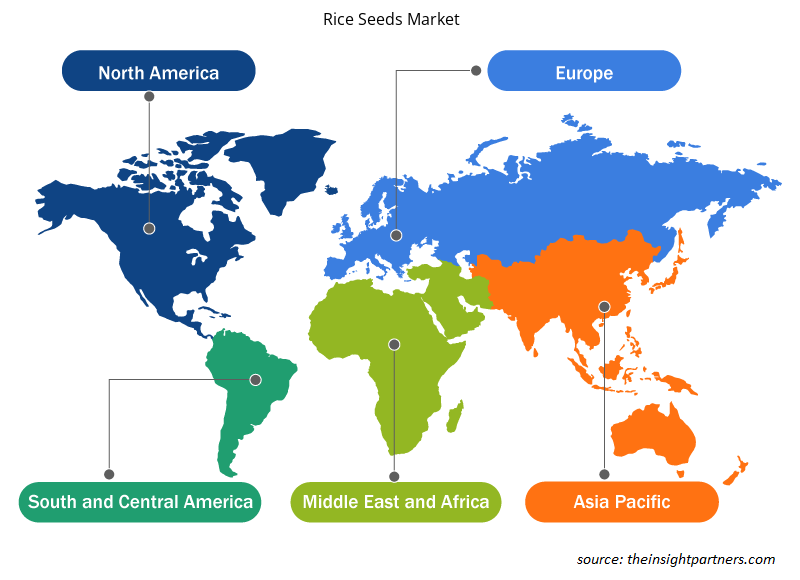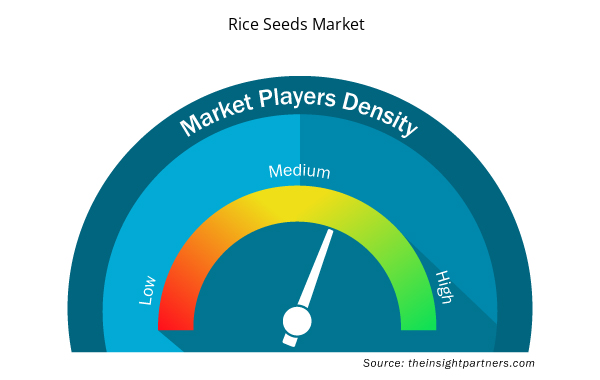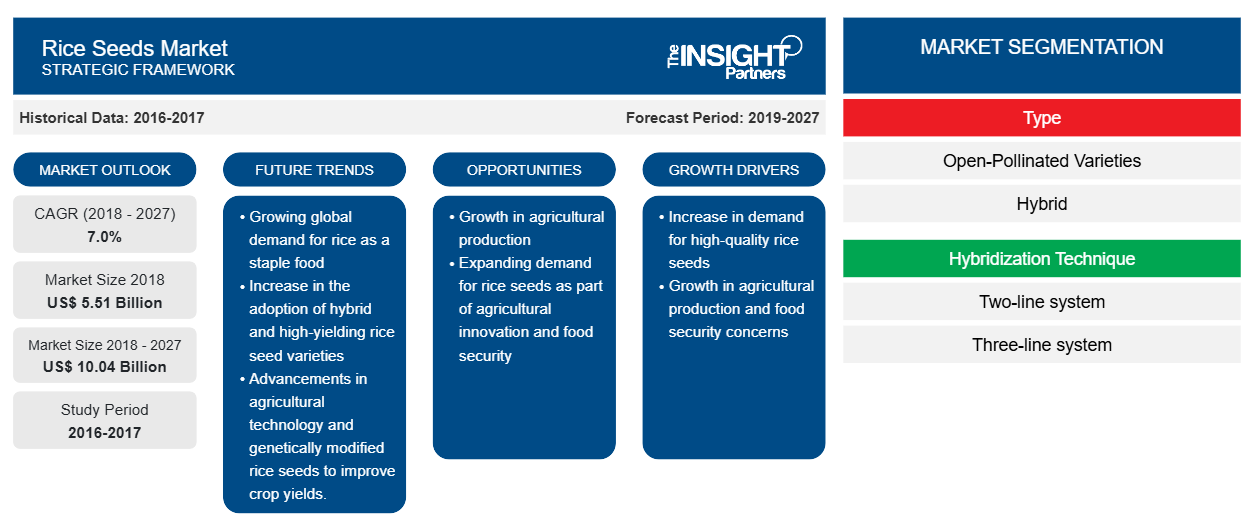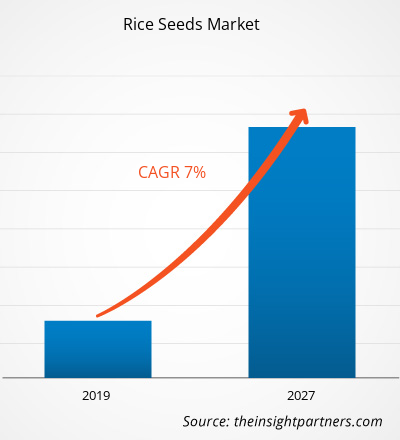بلغت قيمة سوق بذور الأرز 5,506.8 مليون دولار أمريكي في عام 2018 ومن المتوقع أن تصل إلى 10,036.0 مليون دولار أمريكي بحلول عام 2027؛ ومن المتوقع أن تنمو بمعدل نمو سنوي مركب قدره 7.0٪ من عام 2019 إلى عام 2027.
الأرز هو غذاء أساسي في العديد من الدول الكبرى، وخاصة في منطقة آسيا والمحيط الهادئ. بذور الأرز، المعروفة أيضًا باسم الأرز الأسمر، هي بذور أرز كاملة، وتحتوي حبة الأرز الأسمر على حبة أرز واحدة. وهي بذور من نوع أوريزا غلابيريما أو أوريزا ساتيفا. علاوة على ذلك، تُستخدم بذور الأرز كمفاعلات حيوية لإنتاج الأدوية البشرية مثل الببتيدات أو البروتينات العلاجية.
من المتوقع أن ينمو سوق بذور الأرز في منطقة آسيا والمحيط الهادئ بأعلى معدل نمو سنوي مركب خلال الفترة المتوقعة. ويعزى نمو السوق في هذه المنطقة بشكل أساسي إلى الكثافة السكانية العالية، والتي تنمو باستمرار، وخاصة في دول مثل الهند والصين. بالإضافة إلى ذلك، يقع حوالي ربع السكان المقيمين في الدول الآسيوية في فئة الفقراء. ومن المتوقع أن تقود هذه الدول استهلاك الأرز في دول منطقة آسيا والمحيط الهادئ. ومع ذلك، في دول مثل اليابان وكوريا الجنوبية، حيث الدخل مرتفع للغاية، بدأ استهلاك الأرز للفرد في الانخفاض. إن الزيادة المستمرة في عدد السكان ونقص مساحة الزراعة هما من القضايا الرئيسية التي يجب معالجتها في سوق بذور الأرز العالمية . هناك حاجة ماسة لزيادة إنتاجية زراعة الأرز لتلبية الاحتياجات المتزايدة في جميع أنحاء منطقة آسيا والمحيط الهادئ.
قم بتخصيص هذا التقرير ليناسب متطلباتك
ستحصل على تخصيص لأي تقرير - مجانًا - بما في ذلك أجزاء من هذا التقرير، أو تحليل على مستوى الدولة، وحزمة بيانات Excel، بالإضافة إلى الاستفادة من العروض والخصومات الرائعة للشركات الناشئة والجامعات
- احصل على أهم اتجاهات السوق الرئيسية لهذا التقرير.ستتضمن هذه العينة المجانية تحليلاً للبيانات، بدءًا من اتجاهات السوق وحتى التقديرات والتوقعات.
رؤى السوق
من المتوقع أن يؤدي زيادة استخدام البذور الهجينة ذات الإنتاجية العالية إلى تعزيز نمو سوق بذور الأرز
مع تزايد عدد سكان العالم، من المتوقع أن يرتفع الطلب على الأرز لتلبية الاستهلاك الغذائي المتزايد في السنوات القادمة. ومع ذلك، نظرًا لتوافر موارد المياه والأراضي المحدودة، فإن زيادة إنتاج الأرز تشكل تحديًا للمزارعين. والحل الوحيد لمعالجة هذه المشكلة هو زيادة إنتاجية بذور الأرز. في السنوات القليلة الماضية، كانت إنتاجية الأرز راكدة أو متراجعة في بعض مناطق العالم، ويرجع ذلك أساسًا إلى التحسينات الهامشية في إمكانات إنتاج الأرز. يقدم تطوير البذور الهجينة حلاً للدول لتعزيز إنتاجية الأرز وتحقيق الاكتفاء الذاتي في إنتاج الأرز. أدت التطورات التكنولوجية المتزايدة في مجال البيولوجيا الجزيئية والتكنولوجيا الحيوية وعلم الجينوم إلى تحسينات كبيرة في تربية الأرز الهجين. بالإضافة إلى ذلك، أدت الاستثمارات الجارية في البحث والتطوير والاتجاه المتزايد للشراكة بين القطاعين العام والخاص في مجال إنتاج بذور الأرز الهجين إلى زيادة اعتماد البذور الهجينة خاصة بين المزارعين التجاريين. ومن المتوقع أن تؤدي كل هذه العوامل إلى دفع الطلب على البذور الهجينة خلال فترة التنبؤ.
رؤى النوع
بناءً على النوع، ينقسم سوق بذور الأرز إلى أصناف ملقحة مفتوحة وأصناف هجينة. الأصناف الملقحة المفتوحة من بذور الأرز هي نتيجة التلقيح الطبيعي للنبات الأم. وتشمل طرق التلقيح في هذه الفئة التلقيح الذاتي والتلقيح بواسطة الحشرات والطيور وغيرها من الوسائل الطبيعية. وعلى عكس البذور الهجينة، تنتج هذه البذور نباتات مطابقة للنباتات الأم وتعرف باسم الأصناف القياسية في بعض الحالات. ويعتمد اختيار الأصناف الملقحة المفتوحة على متطلبات المزارع. وتحتفظ الأصناف الملقحة المفتوحة عند التكاثر بنفس الخصائص، إذا تم صيانتها وإنتاجها بكفاءة. وتُظهِر بذور الأرز الملقحة المفتوحة خصائص أكثر تنوعًا وراثيًا لأنها تتكيف ببطء بناءً على ظروف النمو ومناخ المنطقة. ويفضل المزارعون التجاريون البذور الهجينة على الأصناف الملقحة المفتوحة للحصول على غلة عالية وخصائص مرغوبة معينة. وفي حين تقدم البذور الهجينة بعض الفوائد مقارنة بالأصناف الملقحة المفتوحة، تساعد الأصناف الملقحة المفتوحة في الحفاظ على التنوع الجيني للنباتات. ومن المتوقع أن يؤدي الطلب المتزايد على الأرز المزروع بشكل طبيعي وغيره من المنتجات الغذائية على مستوى العالم إلى دفع سوق الأصناف الملقحة المفتوحة في السنوات القادمة.
رؤى حول تقنية التهجين
بناءً على تقنية التهجين، يتم تقسيم سوق بذور الأرز إلى نظام ثنائي الخط ونظام ثلاثي الخطوط. استحوذ قطاع نظام ثنائي الخط على أكبر حصة سوقية في عام 2018. تتضمن بعض مزايا الهجائن ثنائية الخط عدم وجود متطلبات لخطوط الصيانة، واختيار الوالدين الواسع لتطوير الهجائن غير المتجانسة، وعدم وجود آثار سلبية من السيتوبلازم العقيم. لا يختلف الإنتاج الكلي للبذور ثنائية الخط كثيرًا عن الهجائن ثلاثية الخطوط. أحد الاعتبارات المهمة في إنتاج بذور الهجائن ثنائية الخط هو تحديد الموقع أو الموسم المناسب. من المتوقع أن تعمل المزايا التي يوفرها نظام ثنائي الخط على دفع الطلب على الهجائن ثنائية الخط خلال فترة التنبؤ.
ومن بين الشركات القليلة العاملة في سوق بذور الأرز شركة BASF SE، وBayer AG، وDuPont de Nemours, Inc.، وGuard Rice Mills، وKaveri Seeds، وMahyco، وNuziveedu Seeds Limited، وRallis India Limited، وRasi Seeds (P) Ltd.، وSL-Agritech وغيرها الكثير. وتنفذ الشركات الرئيسية عمليات الدمج والاستحواذ، واستراتيجيات البحث والتطوير لتوسيع قاعدة العملاء والحصول على حصة كبيرة في السوق العالمية، مما يسمح لها أيضًا بالحفاظ على اسم علامتها التجارية عالميًا.
تقرير يسلط الضوء على
- اتجاهات الصناعة التقدمية في سوق بذور الأرز لمساعدة اللاعبين على تطوير استراتيجيات فعالة طويلة الأجل
- استراتيجيات نمو الأعمال التي تتبناها الأسواق المتقدمة والنامية
- التحليل الكمي لسوق بذور الأرز من 2019 إلى 2027
- تقدير الطلب العالمي على بذور الأرز
- تحليل PEST لتوضيح فعالية المشترين والموردين العاملين في الصناعة
- التطورات الأخيرة لفهم سيناريو السوق التنافسي
- اتجاهات السوق وتوقعاتها بالإضافة إلى العوامل التي تدفع وتكبح نمو سوق بذور الأرز
- المساعدة في عملية اتخاذ القرار من خلال تسليط الضوء على استراتيجيات السوق التي تدعم المصلحة التجارية، مما يؤدي إلى نمو السوق
- حجم سوق بذور الأرز في مختلف العقد
- نظرة عامة مفصلة وتقسيم السوق، بالإضافة إلى ديناميكيات صناعة بذور الأرز
- حجم سوق بذور الأرز في مختلف المناطق مع فرص نمو واعدة
بذور الأرز
رؤى إقليمية حول سوق بذور الأرز
لقد قام المحللون في Insight Partners بشرح الاتجاهات والعوامل الإقليمية المؤثرة على سوق بذور الأرز طوال فترة التوقعات بشكل شامل. يناقش هذا القسم أيضًا قطاعات سوق بذور الأرز والجغرافيا في جميع أنحاء أمريكا الشمالية وأوروبا ومنطقة آسيا والمحيط الهادئ والشرق الأوسط وأفريقيا وأمريكا الجنوبية والوسطى.

- احصل على البيانات الإقليمية المحددة لسوق بذور الأرز
نطاق تقرير سوق بذور الأرز
| سمة التقرير | تفاصيل |
|---|---|
| حجم السوق في عام 2018 | 5.51 مليار دولار أمريكي |
| حجم السوق بحلول عام 2027 | 10.04 مليار دولار أمريكي |
| معدل النمو السنوي المركب العالمي (2018 - 2027) | 7.0% |
| البيانات التاريخية | 2016-2017 |
| فترة التنبؤ | 2019-2027 |
| القطاعات المغطاة | حسب النوع
|
| المناطق والدول المغطاة | أمريكا الشمالية
|
| قادة السوق وملفات تعريف الشركات الرئيسية |
|
كثافة اللاعبين في سوق بذور الأرز: فهم تأثيرها على ديناميكيات الأعمال
يشهد سوق بذور الأرز نموًا سريعًا، مدفوعًا بالطلب المتزايد من جانب المستخدم النهائي بسبب عوامل مثل تفضيلات المستهلكين المتطورة والتقدم التكنولوجي والوعي المتزايد بفوائد المنتج. ومع ارتفاع الطلب، تعمل الشركات على توسيع عروضها والابتكار لتلبية احتياجات المستهلكين والاستفادة من الاتجاهات الناشئة، مما يؤدي إلى زيادة نمو السوق.
تشير كثافة اللاعبين في السوق إلى توزيع الشركات أو المؤسسات العاملة في سوق أو صناعة معينة. وهي تشير إلى عدد المنافسين (اللاعبين في السوق) الموجودين في مساحة سوق معينة نسبة إلى حجمها أو قيمتها السوقية الإجمالية.
الشركات الرئيسية العاملة في سوق بذور الأرز هي:
- باسف اس اي
- شركة باير ايه جي
- إي دو بونت دي نيمور وشركاه
- مطاحن الأرز الحراسة
- شركة كافيري للبذور المحدودة
إخلاء المسؤولية : الشركات المذكورة أعلاه ليست مرتبة بأي ترتيب معين.

- احصل على نظرة عامة على أهم اللاعبين الرئيسيين في سوق بذور الأرز
سوق بذور الأرز- حسب النوع
- الأصناف الملقحة بشكل مفتوح (OPV)
- هجين
سوق بذور الأرز – بتقنية التهجين
- نظام الخطين
- نظام ثلاثي الخطوط
سوق بذور الأرز – حسب المعالجة
- تمت معالجته
- غير معالج
سوق بذور الأرز – حسب حجم الحبوب
- حبوب طويلة
- حبوب متوسطة الحجم
- حبيبات قصيرة
نبذة عن الشركة
- التحليل التاريخي (سنتان)، السنة الأساسية، التوقعات (7 سنوات) مع معدل النمو السنوي المركب
- تحليل PEST و SWOT
- حجم السوق والقيمة / الحجم - عالميًا وإقليميًا وقطريًا
- الصناعة والمنافسة
- مجموعة بيانات Excel



Report Coverage
Revenue forecast, Company Analysis, Industry landscape, Growth factors, and Trends

Segment Covered
This text is related
to segments covered.

Regional Scope
North America, Europe, Asia Pacific, Middle East & Africa, South & Central America

Country Scope
This text is related
to country scope.
Trends and growth analysis reports related to Food and Beverages : READ MORE..
The List of Companies
- BASF SE
- Bayer AG
- E. I. du Pont de Nemours and Company
- Guard Rice Mills
- Kaveri Seed Company Ltd
- Maharastra Hybrid Seeds Company Private Limited (Mahyco)
- Nuziveedu Seeds Ltd. (NSL)
- Rallis India Limited
- Rasi Seeds (P) Ltd
- SL Agritech Corporation
The Insight Partners performs research in 4 major stages: Data Collection & Secondary Research, Primary Research, Data Analysis and Data Triangulation & Final Review.
- Data Collection and Secondary Research:
As a market research and consulting firm operating from a decade, we have published and advised several client across the globe. First step for any study will start with an assessment of currently available data and insights from existing reports. Further, historical and current market information is collected from Investor Presentations, Annual Reports, SEC Filings, etc., and other information related to company’s performance and market positioning are gathered from Paid Databases (Factiva, Hoovers, and Reuters) and various other publications available in public domain.
Several associations trade associates, technical forums, institutes, societies and organization are accessed to gain technical as well as market related insights through their publications such as research papers, blogs and press releases related to the studies are referred to get cues about the market. Further, white papers, journals, magazines, and other news articles published in last 3 years are scrutinized and analyzed to understand the current market trends.
- Primary Research:
The primarily interview analysis comprise of data obtained from industry participants interview and answers to survey questions gathered by in-house primary team.
For primary research, interviews are conducted with industry experts/CEOs/Marketing Managers/VPs/Subject Matter Experts from both demand and supply side to get a 360-degree view of the market. The primary team conducts several interviews based on the complexity of the markets to understand the various market trends and dynamics which makes research more credible and precise.
A typical research interview fulfils the following functions:
- Provides first-hand information on the market size, market trends, growth trends, competitive landscape, and outlook
- Validates and strengthens in-house secondary research findings
- Develops the analysis team’s expertise and market understanding
Primary research involves email interactions and telephone interviews for each market, category, segment, and sub-segment across geographies. The participants who typically take part in such a process include, but are not limited to:
- Industry participants: VPs, business development managers, market intelligence managers and national sales managers
- Outside experts: Valuation experts, research analysts and key opinion leaders specializing in the electronics and semiconductor industry.
Below is the breakup of our primary respondents by company, designation, and region:

Once we receive the confirmation from primary research sources or primary respondents, we finalize the base year market estimation and forecast the data as per the macroeconomic and microeconomic factors assessed during data collection.
- Data Analysis:
Once data is validated through both secondary as well as primary respondents, we finalize the market estimations by hypothesis formulation and factor analysis at regional and country level.
- Macro-Economic Factor Analysis:
We analyse macroeconomic indicators such the gross domestic product (GDP), increase in the demand for goods and services across industries, technological advancement, regional economic growth, governmental policies, the influence of COVID-19, PEST analysis, and other aspects. This analysis aids in setting benchmarks for various nations/regions and approximating market splits. Additionally, the general trend of the aforementioned components aid in determining the market's development possibilities.
- Country Level Data:
Various factors that are especially aligned to the country are taken into account to determine the market size for a certain area and country, including the presence of vendors, such as headquarters and offices, the country's GDP, demand patterns, and industry growth. To comprehend the market dynamics for the nation, a number of growth variables, inhibitors, application areas, and current market trends are researched. The aforementioned elements aid in determining the country's overall market's growth potential.
- Company Profile:
The “Table of Contents” is formulated by listing and analyzing more than 25 - 30 companies operating in the market ecosystem across geographies. However, we profile only 10 companies as a standard practice in our syndicate reports. These 10 companies comprise leading, emerging, and regional players. Nonetheless, our analysis is not restricted to the 10 listed companies, we also analyze other companies present in the market to develop a holistic view and understand the prevailing trends. The “Company Profiles” section in the report covers key facts, business description, products & services, financial information, SWOT analysis, and key developments. The financial information presented is extracted from the annual reports and official documents of the publicly listed companies. Upon collecting the information for the sections of respective companies, we verify them via various primary sources and then compile the data in respective company profiles. The company level information helps us in deriving the base number as well as in forecasting the market size.
- Developing Base Number:
Aggregation of sales statistics (2020-2022) and macro-economic factor, and other secondary and primary research insights are utilized to arrive at base number and related market shares for 2022. The data gaps are identified in this step and relevant market data is analyzed, collected from paid primary interviews or databases. On finalizing the base year market size, forecasts are developed on the basis of macro-economic, industry and market growth factors and company level analysis.
- Data Triangulation and Final Review:
The market findings and base year market size calculations are validated from supply as well as demand side. Demand side validations are based on macro-economic factor analysis and benchmarks for respective regions and countries. In case of supply side validations, revenues of major companies are estimated (in case not available) based on industry benchmark, approximate number of employees, product portfolio, and primary interviews revenues are gathered. Further revenue from target product/service segment is assessed to avoid overshooting of market statistics. In case of heavy deviations between supply and demand side values, all thes steps are repeated to achieve synchronization.
We follow an iterative model, wherein we share our research findings with Subject Matter Experts (SME’s) and Key Opinion Leaders (KOLs) until consensus view of the market is not formulated – this model negates any drastic deviation in the opinions of experts. Only validated and universally acceptable research findings are quoted in our reports.
We have important check points that we use to validate our research findings – which we call – data triangulation, where we validate the information, we generate from secondary sources with primary interviews and then we re-validate with our internal data bases and Subject matter experts. This comprehensive model enables us to deliver high quality, reliable data in shortest possible time.


 احصل على عينة مجانية لهذا التقرير
احصل على عينة مجانية لهذا التقرير